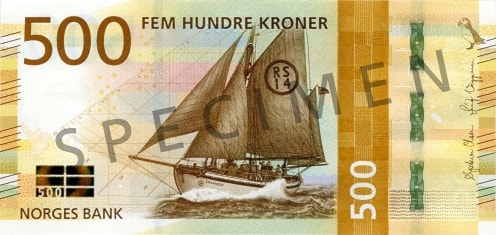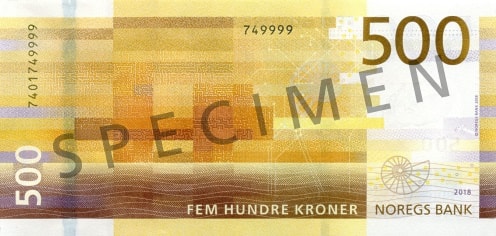New 500-krone note - motifs
Size in mm: 147 x 70

Obverse side
The primary motif on the 500-krone note is the rescue vessel RS 14 "Stavanger", designed by Norway's most famous shipbuilder, Colin Archer.
The vessel was built at Archer's shipyard in Larvik and launched in 1901. It had a total of 37 years of active duty for Redningsselskapet (Norwegian Society for Sea Rescue). The primary motif on the note is designed on the basis of Redningsselskapet's photo, taken by Robby Madsen.
The sea holds vast natural resources, but is also characterised by powerful forces. Storms and wrecks are a fact of life for those who seek to harvest the riches of the sea. The availability of help when it is needed most saves many lives, and gives us greater confidence when we set sail for work or pleasure.
Today, Redningsselskapet's operations are run from tens of stations spread across the entire country. More than 40 rescue vessels are at the ready 24 hours a day the year round along the entire coast.
In the upper-right corner of the banknote you can see an Atlantic puffin. The head of a puffin and the value of the banknote are also featured in the watermark used on all the denominations.

Reverse side
In the pattern of the 500-krone note an oil platform vaguely appears on the horizon. There are high winds and the rectangular forms are longer than on the 200-krone note.
The sea heaps up in the organic pattern. You can also see the North Sea gas pipeline network and a fossil.
The gas pipeline system is a stylised rendition (white lines) of portions of the system for gas transport from Norway to other countries, a design element based on information from Gassco's website in August 2016.
Shipping, fisheries and other activities associated with the sea have long been the basis of economic growth and prosperity in Norway. In the last 50 years, oil and gas activity has become one of the pillars of the Norwegian economy,
The activities have positive spillover effects both nationally and locally. Technological innovations have followed, providing small local communities with additional legs to stand on.
The ability to build new expertise and new industries from what we have learned through harvesting Norway's natural resources can be decisive for future economic developments.